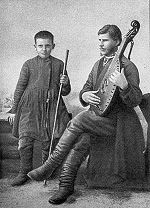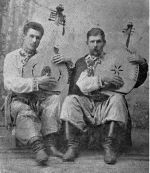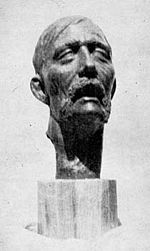
Ivan Kuchuhura Kucherenko
Encyclopedia




Kobzar
A Kobzar was an itinerant Ukrainian bard who sang to his own accompaniment.-Tradition:Kobzars were often blind, and became predominantly so by the 1800s...
) and one of the most influential kobzars of the early 20th century. For his artistry he was awarded the title "People's artist of Ukraine" in 1919 and later "People's Artist of the Ukrainian Soviet Socialist Republic
Ukrainian SSR
The Ukrainian Soviet Socialist Republic or in short, the Ukrainian SSR was a sovereign Soviet Socialist state and one of the fifteen constituent republics of the Soviet Union lasting from its inception in 1922 to the breakup in 1991...
" in 1926.
Childhood
Ivan Kucherenko (or as he later became known, Kuchuhura-Kucherenko) was born on July 7, 1874 in the village of MurafaMerefa
Merefa is a city in eastern Ukraine. It is located in the Kharkivsky Raion of the Kharkiv Oblast .The current estimated population is around 23,679 ....
, of the Bohodukhiv Raion
Bohodukhiv
Bohodukhiv is a city in the Kharkiv Oblast of eastern Ukraine. It is the administrative center of the Bohodukhivsky Raion , and is located on the Kharkiv-Sumy railway at around ....
, in the Kharkov Governorate
Kharkov Governorate
Kharkiv Governorate or Kharkov Governorate was a governorate of the Russian Empire originally founded in 1780. It was renamed to Sloboda Ukraine Governorate in 1797 and back to Kharkiv Governorate in 1835....
of the Russian Empire
Russian Empire
The Russian Empire was a state that existed from 1721 until the Russian Revolution of 1917. It was the successor to the Tsardom of Russia and the predecessor of the Soviet Union...
. At the age of 3, he became fully blind in his left eye and had some damage in his right eye. At the age of 8, he lost his father and became an orphan.
The young Kucherenko had exceptional musical talent which directed him to the lifestyle of a kobzar
Kobzar
A Kobzar was an itinerant Ukrainian bard who sang to his own accompaniment.-Tradition:Kobzars were often blind, and became predominantly so by the 1800s...
. He was apprenticed to the kobzar Pavlo Hashchenko
Pavlo Hashchenko
Pavlo Ivanovych Hashchenko was a Ukrainian kobzar and bandura player.Hashchenko was originally from Poltava province but lived most of his life in the village of Konstantynivka, Bohodukhiv county, Kharkiv province....
and began to perform as a kobzar at the turn of the 20th century.
Education and performances
In 1902, Kucherenko participated in the 12th Archeological Conference held in KharkivKharkiv
Kharkiv or Kharkov is the second-largest city in Ukraine.The city was founded in 1654 and was a major centre of Ukrainian culture in the Russian Empire. Kharkiv became the first city in Ukraine where the Ukrainian Soviet Socialist Republic was proclaimed in December 1917 and Soviet government was...
where he was the youngest participant - at age 24.
The performance at the conference was organized by Hnat Khotkevych
Hnat Khotkevych
Hnat Martynovych Khotkevych December 31, 1877 in Kharkiv, Russian Empire – October 8, 1938 in Kharkiv, in the Ukrainian SSR of the Soviet Union) was a Ukrainian writer, ethnographer, playwright, composer, musicologist, and bandurist....
who noticed that the kobzar
Kobzar
A Kobzar was an itinerant Ukrainian bard who sang to his own accompaniment.-Tradition:Kobzars were often blind, and became predominantly so by the 1800s...
was exceptionally gifted artistically, and during the preparation of the concert, spent a considerable amount of time with him. This association with Khotkevych left a significant impression on Kucherenko as he was able to learn much from Khotkevych. Khotkevych wrote in his memoirs:
In 1906, Kucherenko was performing at the market in Yekaterinoslav (now Dnipropetrovsk
Dnipropetrovsk
Dnipropetrovsk or Dnepropetrovsk formerly Yekaterinoslav is Ukraine's third largest city with one million inhabitants. It is located southeast of Ukraine's capital Kiev on the Dnieper River, in the south-central region of the country...
) and was heard by the renowned historian Dmytro Yavornytsky
Dmytro Yavornytsky
Dmytro Yavornytsky , was a noted Ukrainian historian, archeologist, ethnographer, folklorist, and lexicographer. He was one of the most prominent researchers of the Ukrainian Cossacks, especially the Zaporozhian Cossacks , and the author of their first general history...
. Kucherenko's high artism left a deep impression on Yavornytsky. Yavornytsky wrote:
He invited Kucherenko to his home and later sent him to Myrhorod
Myrhorod
Myrhorod or Mirgorod is a city in the Poltava Oblast of central Ukraine. Serving as the administrative center of the Myrhorodskyi Raion , the city itself is also designated as a separate raion within the oblast, and is located on the river Khorol.-History:The town was founded either in the 12th...
to further master his bandura performance under the guidance of Opanas Slastion
Opanas Slastion
Opanas Georgievych Slastion was a Ukrainian graphic artist, painter and ethnographer.He was born in the Ukrainian port town of Berdyansk on the Berdyansk Gulf of the Sea of Azov...
. For three months Kucherenko lived and studied at Slastion's house, where upon he returned to Yekaterinoslav and thanked the professor for his fatherly guardianship. Kucherenko demonstrated his newly acquired artistic skills to the professor, who was extremely satisfied, and very moved. Yavornytsky organized a concert for the kobzar in Yekaterinoslav, which was a resounding success and helped elevate the popularity of Kucherenko as an exceptionally talented folk singer.
In 1908, Kucherenko was invited to work as a teacher at the Mykola Lysenko
Mykola Lysenko
Mykola Vitaliiovych Lysenko was a Ukrainian composer, pianist, conductor and ethnomusicologist.- Biography :Lysenko was born in Hrynky, Kremenchuk Povit, Poltava Governorate, the son of Vitaliy Romanovich Lysenko . From childhood he became very interested in the folksongs of Ukrainian peasants and...
's music school
Lysenko music school
Lysenko music school is a private music school organized by Ukrainian composer Mykola Lysenko.-Bandura classes at Lysenko's Music School:In the Fall of 1908 the first bandura classes were organized at Mykola Lysenko's Music School....
in Kiev
Kiev
Kiev or Kyiv is the capital and the largest city of Ukraine, located in the north central part of the country on the Dnieper River. The population as of the 2001 census was 2,611,300. However, higher numbers have been cited in the press....
. Here he worked for a period of 18 months. The work was difficult, and he was unable to continue it. He resumed his concertizing where he remained a master performer.
Kucherenko was a virtuoso player of the bandura and had an exceptional baritone voice which left an excellent impression on the audience. Khotkevych noted:
In 1913, Kucherenko traveled to Saint Petersburg
Saint Petersburg
Saint Petersburg is a city and a federal subject of Russia located on the Neva River at the head of the Gulf of Finland on the Baltic Sea...
on the invitation of T. Pryvalov, on the recommendation of Hnat Khotkevych
Hnat Khotkevych
Hnat Martynovych Khotkevych December 31, 1877 in Kharkiv, Russian Empire – October 8, 1938 in Kharkiv, in the Ukrainian SSR of the Soviet Union) was a Ukrainian writer, ethnographer, playwright, composer, musicologist, and bandurist....
where he had over 40 concerts, mainly at educational establishments. After Saint Petersburg, Kucherenko was invited to Moscow
Moscow
Moscow is the capital, the most populous city, and the most populous federal subject of Russia. The city is a major political, economic, cultural, scientific, religious, financial, educational, and transportation centre of Russia and the continent...
by the "Kobzar" Society where he also performed at ethnographic concerts and evenings organized by the society.
In 1915, Kucherenko gave a highly successful concert at the Kharkiv Public Library.
During the brief period of Ukrainian independence, Kucherenko toured Ukraine with concerts supporting the government of Symon Petliura whom he knew personally. For his activity in supporting the government he was awarded the title "People's Artist of Ukraine" by the then Ukrainian government.
Soviet Period
During the SovietSoviet Union
The Soviet Union , officially the Union of Soviet Socialist Republics , was a constitutionally socialist state that existed in Eurasia between 1922 and 1991....
period, Kucherenko was able to perform even more often. Initially the government supported many of these performances. In 1921, in the city of Bohodukhiv
Bohodukhiv
Bohodukhiv is a city in the Kharkiv Oblast of eastern Ukraine. It is the administrative center of the Bohodukhivsky Raion , and is located on the Kharkiv-Sumy railway at around ....
, a special concert was organized to celebrate his 25th anniversary of being a kobzar and he was one of the first artists to receive the prestigious title of People's Artist of the Ukrainian Soviet Socialist Republic in 1926.
After 1928 Kucherenko began to perform on the grave mound of Taras Shevchenko
Taras Shevchenko
Taras Hryhorovych Shevchenko -Life:Born into a serf family of Hryhoriy Ivanovych Shevchenko and Kateryna Yakymivna Shevchenko in the village of Moryntsi, of Kiev Governorate of the Russian Empire Shevchenko was orphaned at the age of eleven...
in Kaniv
Kaniv
Kaniv is a city located in the Cherkasy Oblast in central Ukraine. The city rests on the Dnieper River, and is also one of the main inland river ports on the Dnieper...
. In the 1930s it is known that he secretly became ordained as an orthodox priest in the Ukrainian Autocephaleous Orthodox Church.
Until recently his true date of death was not officially known. Soviet sources such as the Soviet Encyclopedia stated that he died in 1943 during the German occupation
Reichskommissariat Ukraine
Reichskommissariat Ukraine , literally "Reich Commissariat of Ukraine", was the civilian occupation regime of much of German-occupied Ukraine during World War II. Between September 1941 and March 1944, the Reichskommissariat was administered by Reichskommissar Erich Koch as a colony...
. Recently, it has become known that Kucherenko was arrested and after a period of 8 months of prolonged torture was finally shot by the NKVD
NKVD
The People's Commissariat for Internal Affairs was the public and secret police organization of the Soviet Union that directly executed the rule of power of the Soviets, including political repression, during the era of Joseph Stalin....
in 1937. His body was buried in a mass grave on the territory of the KGB recreational facility in the area of Piatykhatky
Piatykhatky
Piatykhatky is a town and a large railway junction in Dnipropetrovsk Oblast of Ukraine. Population is 20,563 ....
on the outskirts of Kharkiv.
Repertoire
Kucherenko's repertoire included six dumyDuma (epic)
A Duma is a sung epic poem which originated in Ukraine during the Hetmanate Era in the sixteenth century...
(sung epic poems):
- Oleksiy Popovych (probably from Khotkevych)
- About the Poor Widow and her three sons
- Captives lament (from Slastion)
- Khmelnytsky and Barabash (from literary sources)
- The death of Bohdan Khmelnytsky (from literary sources)
- The death of the kozak-bandurist. (from Khotkevych)
Many of the texts of these dumy he learned from books, and the accompaniment he composed himself or sometimes borrowing from other bandurists. His repertoire also included numerous songs of literary origin and songs which he composed himself.
Khotkevych also noted that Kucherenko had lost much of his folk character in his renditions of Ukrainian folk songs.

